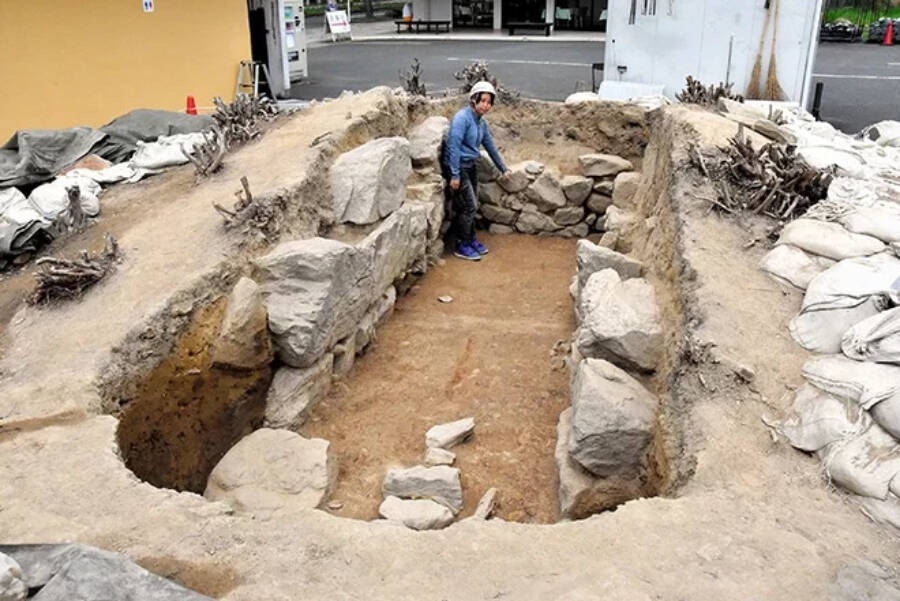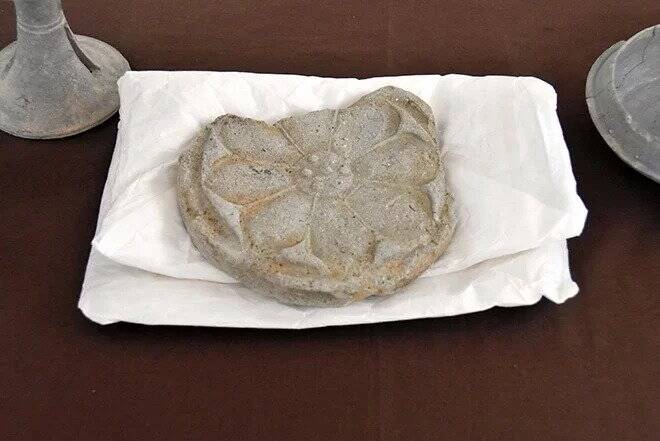Local experts had long suspected that the shrub concealed a tomb, and their hunch proved correct when archaeologists uncovered a kofun burial mound from the sixth century.

Ikaruga Municipal Board of EducationThis parking lot shrub long concealed a sixth-century tomb.
For years, people walking across a parking lot in Nara, Japan, didn’t give the shrub a second glance. It was merely there to beautify the space. But archaeologists working on excavating the grounds of the nearby Horyuji Temple, a World Heritage site, have determined that the shrub was actually planted atop a sixth-century Japanese tomb.
According to The Asahi Shimbun, experts on the Ikaruga Municipal Board of Education had long suspected that the shrub might be hiding ancient secrets. Their hunch proved correct when archaeologists examining the site removed several layers of soil and uncovered an ancient stone tomb about 12 feet long, five feet wide, and three feet high.
The archaeologists also uncovered a number of grave goods, including two iron swords, arrowheads, amber jewelry, clay pots, and several items associated with horse riding. They believe the tomb dates to around the sixth century and was the final resting place for a societal elite.

Kunihiko ImaiThe ancient stone tomb discovered under a parking lot in Nara Prefecture, Japan.
As Arkeo News explains, the trend of building tombs for influential people — called kofun — emerged in the third century and lasted about 400 years. Constructed by high-ranking people, the kofun tombs varied in shape and size. Some were zenpokoenfun (keyhole shaped), while others were enfun (round), and some were as large as 1,300 feet.
There was one oddity about the tomb discovered under the shrub, however. It was missing its roof. But archaeologists have an idea of what happened.
As members of the research team told local media, it’s possible that stones from the tomb’s roof were removed at some point so that they could be used in the construction of the Horyuji Temple and other buildings. The temple was finished in the early seventh century, sometime after the tomb was originally constructed.
“It is possible the ceiling stones were removed for use in the construction of Horyuji temple and the Ikaruga palace, where Prince Shotoku (an influential political leader of the era) lived with his family,” Naohiro Toyoshima, an archaeology professor at Nara University and a member of the research team, told The Asahi Shimbun. “At that point, the stone chamber could have been buried along with all those items.”

Kunihiko ImaiA clay roof tile from the Asuka Period (592-710) which was discovered the stone burial chamber beneath the parking lot shrub.
The archaeologists are investigating the area as part of a wider excavation of the grounds near the Horyuji Temple, a World Heritage site and home to the world’s oldest wooden structures. The temple was originally envisioned by the emperor Yōmei, who vowed to build a temple and an image of Buddha as a way to pray for better health, according to the Horyuji Temple site. Though Yōmei’s prayer didn’t have the effect he wanted — he died shortly after making his vow — work on the temple continued.
As Encyclopedia Britannica notes, structures were added to the site fairly consistently between the seventh and 19th centuries, and are thus a good indication of how interest Buddhism grew in ancient Japan.
For now, not much is known about the societal elite who was buried in the parking lot kofun. Now that their tomb has been uncovered after years of hiding in plain sight, however, perhaps further excavations will reveal more.
After reading about the centuries-old tomb discovered in a Japanese parking lot, see how archaeologists in Japan once discovered an 1,800-year-old wooden ritual mask during the construction of a monorail. Or, go inside the fascinating discovery of human skulls in Japan that suggest that the ancient Hirota people engaged in intentional deformation.





